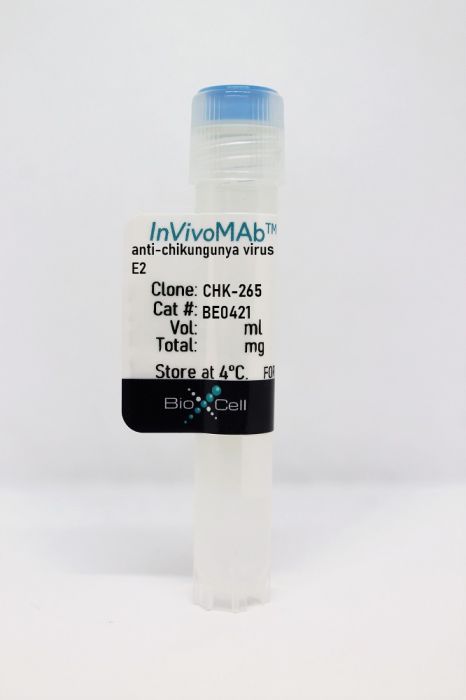InVivoMAb anti-chikungunya virus E2
Product Details
The CHK-265 monoclonal antibody reacts with a conserved epitope on the B domain of the E2 glycoprotein of chikungunya virus. E2 and E1 glycoproteins on the surface of mature virions facilitate binding and entry through receptor-mediated endocytosis and low-pH-mediated fusion within endosomes. CHK-265 has been shown to protect mice against infection by chikungunya, Mayaro, and O’nyong’nyong alphaviruses. This antibody blocks viral entry and egress.Specifications
| Isotype | Mouse IgG2c, λ |
|---|---|
| Recommended Isotype Control(s) | InVivoMAb mouse IgG2c isotype control, anti-dengue virus |
| Recommended Dilution Buffer | InVivoPure pH 7.0 Dilution Buffer |
| Immunogen | OPY-1 strain of CHIKV and soluble recombinant CHIKV E2 protein |
| Reported Applications | Viral entry and egress inhibition |
| Formulation |
PBS, pH 7.0 Contains no stabilizers or preservatives |
| Endotoxin |
<2EU/mg (<0.002EU/μg) Determined by LAL gel clotting assay |
| Purity |
>95% Determined by SDS-PAGE |
| Sterility | 0.2 µm filtration |
| Production | Purified from cell culture supernatant in an animal-free facility |
| Purification | Protein A |
| Molecular Weight | 150 kDa |
| Storage | The antibody solution should be stored at the stock concentration at 4°C. Do not freeze. |
Recommended Products
Viral entry and egress inhibition
Fox JM, Long F, Edeling MA, Lin H, van Duijl-Richter MKS, Fong RH, Kahle KM, Smit JM, Jin J, Simmons G, Doranz BJ, Crowe JE, Fremont DH, Rossmann MG, Diamond MS. (2015). "Broadly Neutralizing Alphavirus Antibodies Bind an Epitope on E2 and Inhibit Entry and Egress" Cell 163(5):1095-1107. PubMed
We screened a panel of mouse and human monoclonal antibodies (MAbs) against chikungunya virus and identified several with inhibitory activity against multiple alphaviruses. Passive transfer of broadly neutralizing MAbs protected mice against infection by chikungunya, Mayaro, and O'nyong'nyong alphaviruses. Using alanine-scanning mutagenesis, loss-of-function recombinant proteins and viruses, and multiple functional assays, we determined that broadly neutralizing MAbs block multiple steps in the viral lifecycle, including entry and egress, and bind to a conserved epitope on the B domain of the E2 glycoprotein. A 16 Å resolution cryo-electron microscopy structure of a Fab fragment bound to CHIKV E2 B domain provided an explanation for its neutralizing activity. Binding to the B domain was associated with repositioning of the A domain of E2 that enabled cross-linking of neighboring spikes. Our results suggest that B domain antigenic determinants could be targeted for vaccine or antibody therapeutic development against multiple alphaviruses of global concern.
Pal P, Dowd KA, Brien JD, Edeling MA, Gorlatov S, Johnson S, Lee I, Akahata W, Nabel GJ, Richter MK, Smit JM, Fremont DH, Pierson TC, Heise MT, Diamond MS. (2013). "Development of a highly protective combination monoclonal antibody therapy against Chikungunya virus" PLoS Pathog 9(4):e1003312. PubMed
Chikungunya virus (CHIKV) is a mosquito-transmitted alphavirus that causes global epidemics of a debilitating polyarthritis in humans. As there is a pressing need for the development of therapeutic agents, we screened 230 new mouse anti-CHIKV monoclonal antibodies (MAbs) for their ability to inhibit infection of all three CHIKV genotypes. Four of 36 neutralizing MAbs (CHK-102, CHK-152, CHK-166, and CHK-263) provided complete protection against lethality as prophylaxis in highly susceptible immunocompromised mice lacking the type I IFN receptor (Ifnar(-/-) ) and mapped to distinct epitopes on the E1 and E2 structural proteins. CHK-152, the most protective MAb, was humanized, shown to block viral fusion, and require Fc effector function for optimal activity in vivo. In post-exposure therapeutic trials, administration of a single dose of a combination of two neutralizing MAbs (CHK-102+CHK-152 or CHK-166+CHK-152) limited the development of resistance and protected immunocompromised mice against disease when given 24 to 36 hours before CHIKV-induced death. Selected pairs of highly neutralizing MAbs may be a promising treatment option for CHIKV in humans.



